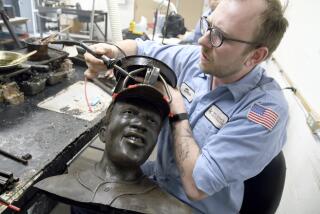Relic of Wounded Knee Returns to United States
- Share via
PIERRE, S.D. — A bullet-riddled tunic, believed taken from the body of a Sioux warrior killed at the 1890 massacre at Wounded Knee, S.D., was put on temporary display here last week after being returned to the United States by a Scottish museum.
Sioux warriors believed the Ghost Dance shirt would protect them in battle and lead to the return of their land. The shirt was displayed in the Kelvingrove Museum in Glasgow, Scotland, for more than a century.
George Crager, a member of Buffalo Bill’s Wild West Show, gave it to the museum in 1892. Three days of ceremonies in South Dakota marked the end of a four-year effort to return the garment.
Accounts differ on what happened at Wounded Knee on Dec. 29, 1890, the last major conflict between U.S. troops and the Indian nations. The government called it a battle and said about 150 Indians were killed and 44 were wounded, while 30 or more soldiers died.
The Sioux say at least 300 Indians and maybe more than 400 were slain at Wounded Knee.
By 1890 the Sioux had been forced onto reservations. The Ghost Dance religion arose with a promise that the land and the decimated buffalo herds would be restored to the Sioux and the white man would be swept away.
After Sioux leader Sitting Bull was killed, Chief Big Foot led a band of about 400 Sioux from central South Dakota to seek refuge at the Pine Ridge Indian Reservation in southwestern South Dakota.
Cavalry troops found Big Foot’s band, and by Dec. 29 the rebuilt 7th Cavalry that Lt. Col. George Custer had commanded at the Little Big Horn joined the other soldiers. Shooting began as the troops were collecting the Indians’ guns.
The fringed cotton tunic, a tangible relic of that day, is adorned with a golden eagle feather, other feathers and a strip of buffalo hide. Stains and several small holes riddle the tunic.
Last Sunday, 29 descendants of victims filed inside a fence around the mass grave at Wounded Knee as Zack Bear Shield offered prayers. Outside the fence stood a crowd of Scots in plaid kilts, area residents, reporters and curious tourists.
Overhead soared a large bird--an eagle, people said, which is sacred to the Lakota.
“He’s bringing good luck,” said Sydney Byrd, an Oglala Lakota.
“We stand here today on hallowed ground,” said Wounded Knee Survivors’ Assn. Secretary Marcella LeBeau, who spearheaded the effort to get the shirt back. “This will bring about a sense of closure to a sad and horrible event. Now healing can begin.”
Survivors walked down a rutted dirt road to the highway, where Mark O’Neill, director of the Kelvingrove Art Gallery, held a black nylon case. After it was purified with the smoke from lighted sage and sweetgrass sticks, the case was opened and a white box removed.
Then Glasgow City Councilor Liz Cameron presented the garment to Sterling Hollow Horn, who carried it back up the hill to the cemetery. Standing in front of the grave’s stone marker, Hollow Horn and Marie Fox Belly unfolded the shirt to the music of bagpipes.
Marie Fox Belly’s grandfather, Dewey Beard, survived Wounded Knee. His parents, brother, wife, son and other relatives did not. Fox Belly said she grew up hearing her grandfather’s accounts of that day in 1890.
“To us it seems as if the massacre happened just yesterday,” she said. “That’s why it’s so close, and I think I feel what he felt.”
Fox Belly and O’Neill both said the return of the Ghost Dance shirt sets a historical precedent for return of Indian treasures from abroad.
“This is the first-ever repatriation from outside the United States of an Indian artifact,” O’Neill told a small crowd at an acceptance celebration in the Cultural Heritage Center museum in Pierre, the state capital.
But O’Neill said he doubts it will open the floodgates for the return of other Indian artifacts from other nations.
“It is only going to be a small number of incredibly special objects, like the Ghost Dance shirt, that will come back,” he said.
In her opening prayer at the ceremony, the Rev. Dora Bruguier of Eagle Butte said the sacred shirt brings back sad memories but is important to Sioux history.
“Lakota people are forgiving people, and we forgive everyone for all the bad things that happened to us long ago,” said Bruguier, whose four grandparents were slain at Wounded Knee.
The shirt will be displayed at the Cultural Heritage Center until a Sioux museum is built at either the Pine Ridge or Cheyenne River Indian reservations. LeBeau said a tribal college on the Cheyenne River Reservation might display the shirt in a log cabin.
More to Read
Sign up for Essential California
The most important California stories and recommendations in your inbox every morning.
You may occasionally receive promotional content from the Los Angeles Times.









